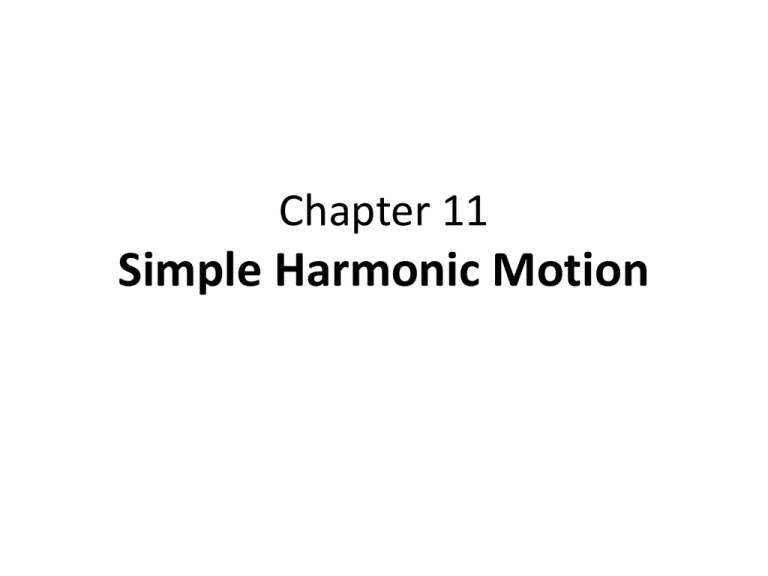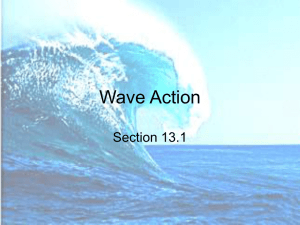Chapter 11 Simple Harmonic Motion
advertisement

Chapter 11 Simple Harmonic Motion Chapter 11 Hooke’s Law • One type of periodic motion is the motion of a mass attached to a spring. • The direction of the force acting on the mass (Felastic) is always opposite the direction of the mass’s displacement from equilibrium (x = 0). Chapter 11 Hooke’s Law, continued At equilibrium: • The spring force and the mass’s acceleration become zero. • The speed reaches a maximum. At maximum displacement: • The spring force and the mass’s acceleration reach a maximum. • The speed becomes zero. Chapter 11 Hooke’s Law, continued • Measurements show that the spring force, or restoring force, is directly proportional to the displacement of the mass. • This relationship is known as Hooke’s Law: Felastic = –kx spring force = –(spring constant displacement) • The quantity k is a positive constant called the spring constant. Chapter 11 Section 1 Simple Harmonic Motion The Simple Pendulum • A simple pendulum consists of a mass called a bob, which is attached to a fixed string. • The x component (Fg,x = Fg sin q) is the only force acting on the bob in the direction of its motion and thus is the restoring force. Measures Chapter 11of Simple Harmonic Motion Simple Chapter 11 Harmonic Motion Period and Frequency • Period and frequency are inversely related: 1 1 f or T T f • Any time you have a value for period or frequency, you can calculate the other value. Chapter Period 11 of a Simple Pendulum in SHM • The period of a simple pendulum depends on the length and on the free-fall acceleration. L T 2 ag length period 2 free-fall acceleration • The period does not depend on the mass of the bob or on the amplitude (for small angles). Period of a Mass-Spring System in SHM • The period of an ideal mass-spring system depends on the mass and on the spring constant. m T 2 k mass period 2 spring constant • The period does not depend on the amplitude. • This equation applies only for systems in which the spring obeys Hooke’s law. Chapter 11 Section 3 Properties of Waves Wave Motion • A wave is the motion of a disturbance. • A medium is a physical environment through which a disturbance can travel. For example, water is the medium for ripple waves in a pond. • Waves that require a medium through which to travel are called mechanical waves. Water waves and sound waves are mechanical waves. • Electromagnetic waves such as visible light do not require a medium. Chapter 11 Relationship Between SHM and Wave Motion As the sine wave created by this vibrating blade travels to the right, a single point on the string vibrates up and down with simple harmonic motion. Wave Types • A wave that consists of a single traveling pulse is called a pulse wave. • Whenever the source of a wave’s motion is a periodic motion, such as the motion of your hand moving up and down repeatedly, a periodic wave is produced. • A wave whose source vibrates with simple harmonic motion is called a sine wave. Thus, a sine wave is a special case of a periodic wave in which the periodic motion is simple harmonic. Chapter 11 Wave Types • A transverse wave is a wave whose particles vibrate perpendicularly to the direction of the wave motion. • The crest is the highest point above the equilibrium position, and the trough is the lowest point below the equilibrium position. • The wavelength (l) is the distance between two adjacent similar points of a wave. v = fl Chapter 11 Wave Types • A longitudinal wave is a wave whose particles vibrate parallel to the direction the wave is traveling. • A longitudinal wave on a spring at some instant t can be represented by a graph. The crests correspond to compressed regions, and the troughs correspond to stretched regions. • The crests are regions of high density and pressure (relative to the equilibrium density or pressure of the medium), and the troughs are regions of low density and pressure. Fig. 21.22, p.675 Chapter 13 Section 1 Characteristics of Light The Electromagnetic Spectrum Crab Nebula—X-ray image Crab Nebula—Optical image The most famous and conspicuous supernova remnant. The Crab Nebula is the centuries-old wreckage of a stellar explosion, or supernova, first noted by Chinese astronomers on July 4, 1054, and that reached a peak magnitude of -6 (about four times brighter than Venus). According to the Chinese records, it was visible in daylight for 23 days and in the night sky to the unaided eye for 653 days. Petroglyphs found in Navaho Canyon and White Mesa (both Arizona) and in the Chaco Canyon National Park (New Mexico) appear to be depictions of the event by Anasazi Indian artists. The Crab Nebula lies about 6,300 light-years away in the constellation Taurus, measures roughly 10 light-years across, and is expanding at an average speed of 1,800 km/s. Surprisingly, its expansion rate seems to be accelerating, driven by radiation from the central pulsar. Its luminosity at visible wavelengths exceeds 1,000 times that of the Sun Crab Nebula—Infrared image Crab Nebula—Radio image







